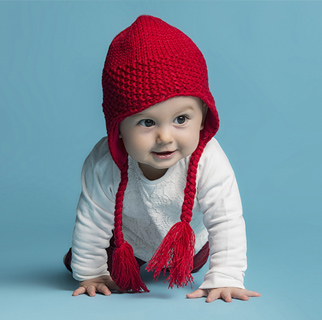The Growing Child: 7 to 9 Months

How much will my baby grow?
While all babies may grow at a different rate, the following is the average for boys and girls 7 to 9 months of age:
Weight: average gain of 1 pound each month; boys usually weigh about ½ pound more than girls; 2 times the birth weight by 4 to 5 months and 3 times the birth weight by 1 year
Height: average growth of about ½ inch each month
Head size: average growth of about ¼ inch each month
What can my baby do at this age?
Babies are rapidly developing their physical abilities at this age. They become mobile for the first time and safety in the home becomes an important issue. Babies may progress at different rates, but these are some of the common milestones your baby may reach in this age group:
Rolls over easily from front to back and back to front
Sits leaning forward on hands at first, then unsupported
Bounces when supported to stand
Gets on hands and feet and rocks back and forth
May creep, scoot, crawl-backward first, then forward
Starts to pull up to stand
Reaches for and grasps objects using whole hand
Bangs toy on table
Can hold an object in each hand
May hold a bottle
Plays peek-a-boo
Grasps object with thumb and finger by 8 to 9 months
Starts teething, usually starting with the 2 center front teeth in the lower jaw, then the 2 center front teeth in the upper jaw
Learns to drink from cup
Puts everything into mouth
Naps are usually twice, sometimes 3 times a day, for 1 to 2 hours each (on average)
May start to awaken during the night and cry
What can my baby say?
It is very exciting for parents to watch their babies become social beings that can interact with others. Every baby develops speech at his or her own rate, but these are some of the common milestones in this age group:
Makes 2 syllable sounds (ma-ma, da-da)
Makes several different vowel sounds, especially "o" and "u"
Repeats tones or sounds made by others
What does my baby understand?
A baby's awareness of people and surroundings increases during this time. Babies may progress at different rates, but these are some of the common milestones in this age group:
Responds to own name and "no"
Pays attention to conversation
Appears to understand some words (such as "eat")
Prefers mother over others
Enjoys seeing self in mirror
Responds to changes in emotions of others
Is afraid of strangers
Shows interest in and dislike of foods
Makes attention-getting sounds, such as a cough or snort
Starts to understand object permanence and can uncover a toy after seeing it covered
May follow one-step commands with a sign to demonstrate such as, "get the ball" while parent points to ball
How to help increase your baby's development and emotional security
Consider the following as ways to foster the emotional security of your baby:
Give your baby safe toys that make noises when shaken or hit.
Play in front of a mirror, calling your baby by name and pointing to your baby's reflection in the mirror.
When talking to your baby, pause and wait for him or her to respond just as when talking with an adult.
Play pat-a-cake and peek-a-boo.
Name common objects when shown to your baby.
Make a variety of sounds with your mouth and tone of voice.
Repeat and expand the sounds your baby makes, such as "ma-ma" when he or she says "ma."
Show picture books and read stories to your baby every day.
Give your baby toys with objects or knobs to push, poke, or turn.
Give your baby toys that stack or nest and show him or her how they work.
Build a tower with your baby and show him or her how to knock it down.
Establish a routine for bath and bedtime.
Offer a cup.
Connect with us:
Download our App: